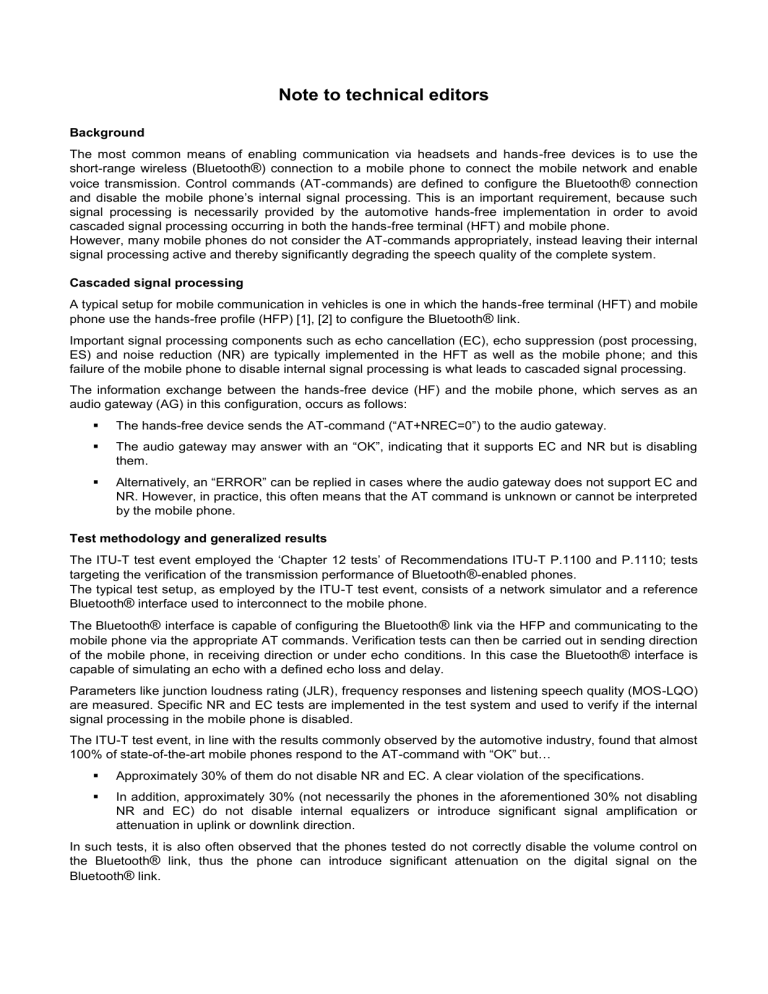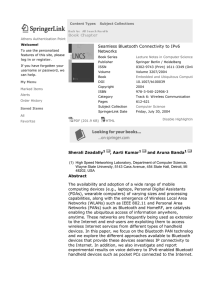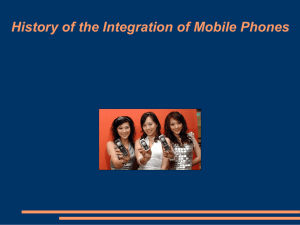Note to technical editors

Note to technical editors
Background
The most common means of enabling communication via headsets and hands-free devices is to use the short-range wireless (Bluetooth ® ) connection to a mobile phone to connect the mobile network and enable voice transmission. Control commands (AT-commands) are defined to configure the Bluetooth ® connection and disable the mobile phone’s internal signal processing. This is an important requirement, because such signal processing is necessarily provided by the automotive hands-free implementation in order to avoid cascaded signal processing occurring in both the hands-free terminal (HFT) and mobile phone.
However, many mobile phones do not consider the AT-commands appropriately, instead leaving their internal signal processing active and thereby significantly degrading the speech quality of the complete system.
Cascaded signal processing
A typical setup for mobile communication in vehicles is one in which the hands-free terminal (HFT) and mobile phone use the hands-free profile (HFP) [1], [2] to configure the Bluetooth ® link.
Important signal processing components such as echo cancellation (EC), echo suppression (post processing,
ES) and noise reduction (NR) are typically implemented in the HFT as well as the mobile phone; and this failure of the mobile phone to disable internal signal processing is what leads to cascaded signal processing.
The information exchange between the hands-free device (HF) and the mobile phone, which serves as an audio gateway (AG) in this configuration, occurs as follows:
The hands-free device sends the AT-command (“AT+NREC=0”) to the audio gateway.
The audio gateway may answer with an “OK”, indicating that it supports EC and NR but is disabling them.
Alternatively, an “ERROR” can be replied in cases where the audio gateway does not support EC and
NR. However, in practice, this often means that the AT command is unknown or cannot be interpreted by the mobile phone.
Test methodology and generalized results
The ITU-T test event employed the ‘Chapter 12 tests’ of Recommendations ITU-T P.1100 and P.1110; tests targeting the verification of the transmission performance of Bluetooth ® -enabled phones.
The typical test setup, as employed by the ITU-T test event, consists of a network simulator and a reference
Bluetooth ® interface used to interconnect to the mobile phone.
The Bluetooth ® interface is capable of configuring the Bluetooth ® link via the HFP and communicating to the mobile phone via the appropriate AT commands. Verification tests can then be carried out in sending direction of the mobile phone, in receiving direction or under echo conditions. In this case the Bluetooth ® interface is capable of simulating an echo with a defined echo loss and delay.
Parameters like junction loudness rating (JLR), frequency responses and listening speech quality (MOS-LQO) are measured. Specific NR and EC tests are implemented in the test system and used to verify if the internal signal processing in the mobile phone is disabled.
The ITU-T test event, in line with the results commonly observed by the automotive industry, found that almost
100% of state-of-the-art mobile phones respond to the AT-command with “OK” but…
Approximately 30% of them do not disable NR and EC. A clear violation of the specifications.
In addition, approximately 30% (not necessarily the phones in the aforementioned 30% not disabling
NR and EC) do not disable internal equalizers or introduce significant signal amplification or attenuation in uplink or downlink direction.
In such tests, it is also often observed that the phones tested do not correctly disable the volume control on the Bluetooth ® link, thus the phone can introduce significant attenuation on the digital signal on the
Bluetooth ® link.
Conclusion
Many Bluetooth ® implementations in mobile phones do not satisfy the Hands-Free Profile Specification. Even the devices indicate explicitly that they have deactivated NR and EC, audio tests prove the contrary.
This is a real issue to HFT manufacturers and car manufacturers and emphasizes the need to run such verification tests.
The test results for wideband Bluetooth ® -enabled mobile phones [2] show that the issues described for narrow-band speech transmission via Bluetooth ® link are equally prevalent in wideband connections.
This is not only problematic for the automotive industry relying on transparent audio performance to tune the signal processing of their hands-free car kits. It is also an issue considering customers’ high expectations regarding the improved speech quality intended to be provided by wideband connections.
Another issue was found during the test event: Some mobile phones disable the internal signal in a
Bluetooth ® link, although the AT-command (“AT+NREC=0”) was not sent to the mobile phone. This may be an issue for the headset industry, as some implementations rely on the signal processing in the mobile phones and therefore do not request them to be disabled.
References
[1] Bluetooth ® SIG, Car working group, Hands-free Profile 1.5 V10r00, Nov. 2005
[2] Bluetooth ® Telephony Working Group: Hands-free Profile 1.6






